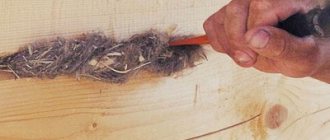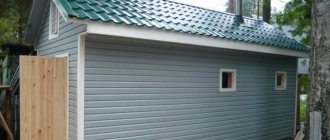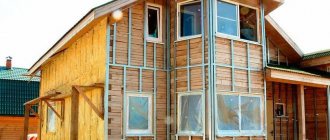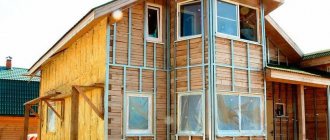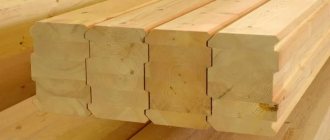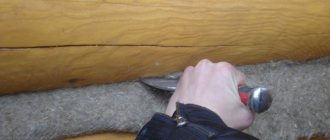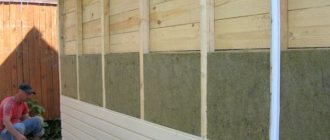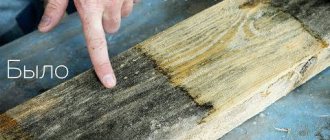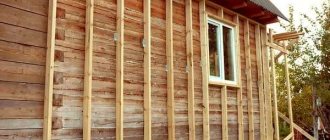Living in wooden houses made of timber is considered to be as comfortable as possible, if you do not forget about insulation measures after the building shrinks, for example, caulking.
Knowing the technologies for caulking timber, the materials for them, and understanding which method can be used in your case, you will be able to do this work quickly and correctly. The result will be a warm and cozy wooden house that meets the requirements of heat conservation and comfort.
Read on and you will learn what and how to caulk a house made of timber, as well as when to do this work, and how to do it correctly.
Caulking a wooden house - necessary after shrinkage Source satom.ru
Is it necessary to caulk a house made of timber?
When constructing timber houses, insulation is laid on each crown. Under its own weight, the log house invariably shrinks. This is a natural process and cannot be avoided. The wood dries out and changes its geometric parameters: the timber “sits”, the insulation wrinkles in places, and cracks appear. This may not be noticeable to the eye, but on average a log house 3 meters high can shrink by 10-12 cm after a year.
Gaps in timber after shrinkage Source content.onliner.by
To improve the thermal performance of a timber house, the timber must be caulked. This procedure is needed for the following purposes:
- Prevent heat leakage . During shrinkage, cracks appear between the crowns of the log house, the so-called “cold bridges”. Drafts appear and heat is blown out. Caulking allows you to retain heat and improve the thermal performance of your home.
- Elimination of icing of walls . In the absence of caulking, heat will escape through the cracks formed when the timber shrinks. Due to the difference in temperatures during the cold season, moisture entering the cracks of the timber freezes, which leads to further cracking of the wood.
- Increased home performance . After caulking, a full thermal balance will be created in the log house. Heat conservation will save resources on heating your home. The log house will be in more comfortable operating conditions in the complete absence of icing on the external and internal walls.
This is what a caulked timber looks like Source 1brus.ru
Caulking is a mandatory step in construction. It will keep the house warm, save heating resources, and also increase the service life of the building as a whole.
Why is caulking of a log house done?
Thermal insulation of a log house helps retain heat in the premises, prevents deformation of the wood and a decrease in its operational parameters. Modern insulation materials are durable, practical and safe, and therefore provide high-quality caulking for wooden buildings.
Log caulking solves the following problems:
- eliminates cold bridges and reduces heat loss at home;
- corrects construction defects;
- eliminates various defects in external and internal corners, crowns, door and window openings;
- makes the house more attractive and reliable;
- increases the service life of wood.
When and how many times should you caulk?
In addition to understanding how to caulk a log house, you need to know when to do the work. Wooden houses are most susceptible to shrinkage during the first year and a half of operation, then over the course of 5-6 years the shrinkage occurs slowly and fades away completely. Caulking is carried out in three stages:
- Primary . Immediately after the construction of the log house is completed. Despite the installation of inter-crown insulation, the joints are additionally sealed with the selected material. Due to the upcoming shrinkage of the house, caulking can be done with a low density.
- Secondary . Produced one year after the construction of the house. The log house will shrink by almost 80%. It is necessary to tightly caulk the cracks that appear and prevent the remaining material from hanging down.
Secondary caulk Source ytimg.com
- Third caulking . Produced 4-6 years after the start of operation of the house. The log house is caulked tightly. All joints in which the insulation has been lost over time are filled.
Double caulking is an indispensable condition for creating an ideal thermal contour of a building. The third time it is necessary to caulk if there is no external cladding of the house. If the outside of the house is insulated with finishing material, there is no need to seal the joints a third time.
The final touch - sanding
Caulking has not yet completed the construction of the log house until it is ready for flooring, installation of the attic floor, roof, installation of windows, doors, partitions, for finishing and equipment - it is desirable to sand the log house, but it is necessary to sand the inside. Especially - chopped from wild logs, debarked by hand.
Sanding a frame with sandpaper is extremely time-consuming, tedious, and this damages the outer most resistant layers of the wood. The frame is sanded using a hand-held universal grinder with nylon brushes. Worse - grinder with them; drive is too powerful. But the main thing here is still brushes for sanding wood, see video review:
Video: review of nylon brushes for sanding logs
Sanding a log frame with a brush is actually a controversial issue: the brush removes the bead of caulk, see fig.:
Sanding a log frame with a nylon brush
It is definitely clear that it is better not to touch the outside of the log house with a brush. However, there is a way to polish the outside of a log house - this is abrasive blasting. The abrasive used is... baking soda, which does not harm either the wood or the caulk. Of course, during your work you must observe all the safety precautions necessary for abrasive blasting. But the process itself can be carried out with a homemade sandblasting machine (sandblasting), because soft abrasive powder is used, see video:
Video description
Description of the “stretch” caulking technology in the video:
This technique is practiced both using natural traditional materials and modern insulation materials, and if the material is represented by a tape or roll, caulking is much easier and faster. When caulking, standard tools are used: a wooden spatula and a wooden hammer.
- “To set” method
This method is used if significant gaps larger than 5 mm in size have formed during the shrinkage of the house.
From the selected material, carefully twist the tourniquet and fold it into loops. The space between the logs is filled with rolled loops, filling wide gaps and minor cracks as tightly as possible. A special spatula and a wooden hammer are used.
Method “to set” Source galich-dom.ru
With this technique, it is recommended to use rolled tape materials, since twisting strands of fibrous materials with the subsequent set of loops is a complex matter. But in general, seams can be sealed with any materials.
How to reduce heat loss
Advertising on the websites of cylinder manufacturers often suggests that you can do without the insulation procedure. Mounting grooves are made on the logs along the entire length, which guarantee a strong connection; moreover, due to the precise workmanship of the bowls, they will fit tightly to each other. Such statements always attract increased attention from future homeowners, but are not always true.
Wood is a living material, and it is extremely difficult to achieve a perfect fit of trunks processed even using special equipment. In addition, it is completely impossible to predict how the wood will behave during shrinkage. Even if deformation cuts are made in the log, it is impossible to determine in advance whether cracks will appear.
Much depends on the thickness of the logs themselves and the quality of their processing. But perfect design is difficult to come by, and even small flaws can significantly deteriorate the thermal insulation qualities of a building.
Insulation not only helps protect the building from drafts, but also neatly levels the walls if any small errors were made during construction. Each crown is checked by level, and if there are deviations, a layer of insulating material can compensate for several millimeters.
Interventional insulation is the easiest way to reduce future heat loss: it requires very little time, does not reduce the environmental friendliness of the building and makes it possible to close possible cracks and irregularities from the very beginning. Rolled insulation can be placed with a double-sided or one-sided bend or without a bend, and after construction, the hanging edges can be carefully driven into the cracks on both sides.
After the shrinkage period, you need to carefully inspect the frame and determine where the walls are deformed with the formation of cracks. This is one of the main disadvantages of a log house. The use of insulation effectively minimizes heat loss.
The tradition of insulating log cabins in Russian construction has existed for a very long time: this is a great opportunity to use not too thick logs and get a warm house. Natural materials are not that expensive, so you can create good insulation at minimal cost.
Taisiya Pavlova
Author of publications on 1Drevo.ru with the topics: GOST for window installation | Round log house | Construction of a country house | Pros of a house made from cylinders | Bathhouse with attic | Wood boiler | Infrared heaters | Okosyachka | Winter construction | Dry timber | Bathhouse made of timber | Frame technology | Wooden stairs, etc.
Collections of publications on topics:
House made of rounded logs Caulk of the house Flax tow
Was this publication useful to you?
Bookmark it on social networks!
Total score: 6Votes: 6
How to build two-story houses and bathhouses from rounded logs
How many years does the main shrinkage of a rounded log house take?
We recommend! — Encyclopedia Wooden Houses — NEW
You can find out detailed and expanded information on the topic of the article from the book “Wooden Houses,” which reflects all stages of building a house, from laying the foundation to installing the roof. Book price = 77 rubles.
You may also be interested in other BOOKS on building houses from wood with your own hands.
We recommend other posts on this topic:
Impregnation for a log house made of rounded logs: rating of products
The nuances of do-it-yourself caulking of a timber house
Technology for insulating a timber house from the outside
Internal covering for a log house - finishing and protection
How to insulate the facade of a wooden house efficiently and cheaply
Waterproofing technology between the log house and the foundation
Technology of caulking a house made of timber
Caulking technology consists of a certain sequence and rules for carrying out work.
First, the lower crowns are caulked; work does not begin from the middle of the frame or the upper crowns.
The work is carried out simultaneously outside and inside strictly along the perimeter of the log house.
You should begin compacting the space between the second and third crowns only when work on all four walls between the first lower crown and the subsequent second is completed. This is done to prevent the house from skewing, because after the insulation is completed, the timber may become about 10 cm higher.
Caulking can be produced using fiber and tape insulation. When caulking with tape material, the work is carried out much faster, and it is much easier to perform.
Tow
This material is waste generated after the primary processing of natural fibers.
The logs are caulked with jute, hemp and flax tow. The properties and quality of such material are determined by the raw materials, the length of the fibers and the level of their purification. During production, tow is pressed into blocks. To use it, you need to pull a strip of material from the block, twist it into a rope and place it in the seam.
Although, it is easier to use tow sold in rolls.
In general, tow is not very convenient to work with, since it is very difficult to get an even seam. When caulking a log house, due to the high rigidity of the material, it is difficult to obtain a tight seam from the first approach. We have to resort to a repeat process.
If you decide how to properly caulk a bathhouse by choosing between moss and jute tow, then you can confidently say that it is better to choose moss, since it does not harbor fungus and bacteria.
Video description
Caulking timber: how it happens is shown in the video:
To understand how to properly caulk a house made of timber, we will consider in detail the methods of caulking with various materials.
Caulking technology with fiber insulation:
- Moss or flax tow is applied to the gap with fibers across it, then, holding the material, it is pressed deep with force with a special spatula.
Caulking tow Source fasad-exp.ru
Advice from the experts
Caulk with jute rope
- The walls of a house made of edged timber do not always have an attractive appearance; it is almost impossible to lay insulation between the crowns without unevenness, so it will not be possible to caulk the frame “string by thread”. You can decorate the facade using jute rope, which is laid over a layer of inter-crown insulation; the rope is secured with clapboard nails.
- After finishing caulking, it is advisable to treat the crown gaps with an antiseptic; the domestic drug “Neomid” is an effective remedy. The product provides long-term protection of insulation made from natural materials from rotting, fungus and insects. It has a liquid consistency and is applied with a brush.
- If the frame is sanded after shrinkage, finishing caulk is carried out last - after sanding of the walls is completed.
Video description
Caulking with rolled material: you will see how to do it correctly in the video:
The corners of the timber are caulked using the same technology:
- If the gaps are wide, a cord is formed from the insulation tape. Roll it into a ball.
- Unwind part of the cord and weave loops from it. Then each loop is pushed inside the seam.
- Hammer the loops with a spatula, first from above the joint, then from below.
- After sealing the seams, final caulking is carried out if necessary. It involves residual filling of joints and is carried out if necessary.
- The density of the caulk is checked with a kitchen knife. The knife blade should not extend into the joint more than 1.5 cm. If this condition is met, caulking is done correctly. If not, then additional caulking is required.
Checking the density of the caulk Source 24aul.ru
Caulking corners is done using the same technologies using roll insulation, for this they move along the seam from the bottom up. To ensure uniform laying of the material, it is constantly tensioned and straightened.
Caulking corners
The corners in the log house are insulated after the main work is completed.
To do this, it is better to use rolled insulation and curved caulk. The process works as follows:
- The free edge of the tape insulation is applied to the seam located in the corner and filled with crooked caulk.
- After installing the material, its free edges are rolled up and hammered into the seam.
- All work on laying insulation is carried out from top to bottom. To ensure uniform driving, the material is carefully stretched and straightened.
Briefly about the main thing
Caulking involves sealing cracks in a log house with insulating material. It is necessary to caulk the house after the timber shrinks. This must be done twice, and in the absence of outer cladding - three times.
Caulking is done using various materials. The main thing is that they meet the requirements of heat conservation, are environmentally friendly and durable in use. Traditional materials are represented by moss, tow and hemp. Modern ones - jute and linen felt.
Depending on the width of the gaps that appear after shrinkage, they can be caulked in two different ways using rolled or fibrous materials: the “stretch” method or the “set-up” method.
Materials
The quality of the caulk is determined equally by compliance with the technology and the materials used for caulking. They are divided into main and auxiliary. The main ones are natural; auxiliary, for example, for sealing gaping cracks during restoration - modern synthetic ones. Synthetic caulk has every chance of becoming the main caulking material over time, but has not yet passed the full test of time. Extrapolation from laboratory data gives a service life of 120 years for some wood sealants (see below). Most likely, it is much larger, but there is not yet enough data from nature to say exactly how much.
The undoubted advantage of natural caulk is that it contains the strength base of wood - lignin - and substances that can interact with living tissues of the tree. Both of these “blind” the logs or beams of a log house very firmly over time.
Note: in the cambium - the layer of dicotyledonous trunks that grows in width - there is still little lignin, and there is much more living tissue than in the deeper, increasingly lignified layers. Therefore, a properly caulked log house made from hand-barked wild logs is much more durable than one made from lumber.
So, you can choose the following material for caulking (see figure):
Materials for caulking a log house
- Moss, bog sphagnum or wood moss does not “glue” logs/beams together very tightly, but it does a good job of protecting the inner layers of wood exposed during processing from moisture and pest attacks. In a constantly warm room, seemingly completely dead moss can be awakened by moisture (herbarium specimens were able to be revived after 200-250 years) and damage the entire frame, so it is advisable to caulk unheated buildings with moss. Especially the bathhouse. A real Russian bathhouse is not only built from selected wild logs, but also caulked with marsh moss, see below;
- Hemp tow is an inexpensive material that is durable enough for caulking small unheated non-residential buildings: a log house for a well, a gazebo, a country house, etc. Not very suitable for heated buildings, because at temperatures slightly above room temperature and high humidity, it rots. In the old days, hemp tow was used to caulk poor peasants' huts that were heated in the black way, hence the very word “caulk.” Working with hemp tow is not very convenient: it clings strongly to wood and wooden tools, see below, and breaks with metal ones;
- Linen tow for caulking is expensive, but the best material for this purpose. It is unusually strong and durable (especially when impregnated with linseed oil): in mid-latitudes, archaeologists find pieces of linen fabric that have not yet decayed in Stone Age burials. The bandages of the mummies of Ancient Egypt were also woven from flax. It is very convenient to work with flax tow: it is just the right amount of slippery and elastic.
- Jute tape and cord for caulking are not very expensive materials; their properties are average between hemp and flax. It’s easy to use and allows you to use some techniques that significantly simplify and speed it up, see below. Suitable for caulking residential buildings for a long time: in the Himalayas, Karakoram and Tibet there are buildings caulked with jute that are over 200 years old. Therefore, the material of the article is focused more on caulking with jute.
- Strands of extruded polyethylene foam and polyurethane sealant are used for “aesthetic” caulking of log houses, the service life of which will definitely not be much longer than the standard, for example, made of laminated veneer lumber. Another purpose is to seal gaping cracks in unimportant parts of buildings, see below.
Basic principles
The quality of the log house's assembly is determined by how the crowns are laid. It is important not only to cut out the bowls and grooves correctly, but also to lay inter-crown insulation between two rows of logs or beams.
The insulation is installed during the assembly stage of the log house
What it will be - moss, tow or jute - is up to you, but such a layer must be present. When building a log house, you need to lay insulation in two layers:
- on the lower crown so that the edges of the insulation protrude beyond the edges of the bowl by 3-5 cm, the width of the insulation, in general, is taken 5-10 cm more than the width of the bowl;
- Insulation is also placed in the bowl of the upper crown; its edges protrude beyond the bowl by 3-5 cm.
Please note that when using moss or tow, there is no need to “tap” the material. When tapped with a hammer or an ax butt, the moss fibers break and dents form on the wood, which are directed across the fibers. Such damage can lead, in the future, to the development of foci of rotting. It is enough to simply compact the fibers with the palm of your hand, leveling and probing the layer; if you come across large foreign objects (cones or sticks are often found in moss), simply remove them.
Laying moss when assembling a log house
When using tape insulation, you can fix it using a construction stapler - damage to the wood from the staples is minimal, and the material is held securely. It is advisable for two people to lay the “insulated” crowns so that they can take the log from both ends and lower it so as not to move the insulation.
Services of professional caulkers
Entrust the caulking of your home or bathhouse to qualified specialists who will quickly and efficiently complete all the work.
We employ caulkers with ten years of experience who are well aware of all the subtleties and nuances of caulking. We use high-quality and dried natural materials that meet all requirements. We work under a contract and provide quality guarantees. Our specialists will make caulking of any complexity and volume at an affordable cost. Contact us in any convenient way using the coordinates in the “Contacts” section. Calculate the cost of painting and insulating your home right now
Do you have accurate measurements of the house?
I measured it myself. I have a house design. Measurers came. I want to call a measurer.
By clicking on the button, you consent to the processing of personal data
Technology and rules for painting an old wooden house
How to properly varnish a wooden floor
Features of insulating a log house with penoplex
Insulation of a wooden house with Accent 125 sealant
Moss
Moss is considered the most common, time-tested material for caulking. It has been used for hundreds of years. Currently, there are many other materials, but they all have slightly worse characteristics. True, new materials are easier to operate, and they also have such positive qualities as antibacterial properties and special resistance to rotting.
Before caulking a log bathhouse with moss, it must be dried and soaked right before use. This action will give the moss fibers elasticity. The moss is laid out in a layer and leveled so that its ends hang down on both sides of the beam. After all the logs have been laid out, the excess moss fibers are shortened, and what remains is wrapped and tucked into the cracks. Thus, the first stage of caulking the log house is carried out. Further stages of caulking will be continued after a year and a half.
Summarizing the above
The caulking of the bathhouse, according to all the rules, retains thermal energy in the bathhouse and significantly extends its service life.
Improperly carried out work on insulating a building will lead to its rapid cooling, rotting of the log house and the breeding of pests in it. Remodeling takes a lot of time, effort and material costs. Properly performed work will help increase the service life of the bathhouse. The erected structure will delight you for many years with its warmth, power and solidity.
Proper insulation of a bathhouse can be the key to its good quality and optimal heat retention. You can caulk the walls of such a building yourself, thereby significantly saving money
It is important to know well the basic rules of the process. Typically, such work extends significantly over a long period.
Note that the basic process of insulating a bathhouse has become a tradition; it is no different from the methods that were used by our distant ancestors during the reign of kings and monarchs. The process of caulking a bathhouse seems to be a complex and painstaking process that requires a lot of time and effort. Its implementation must be approached only with certain knowledge and practical work skills.
